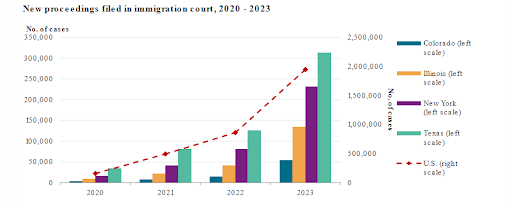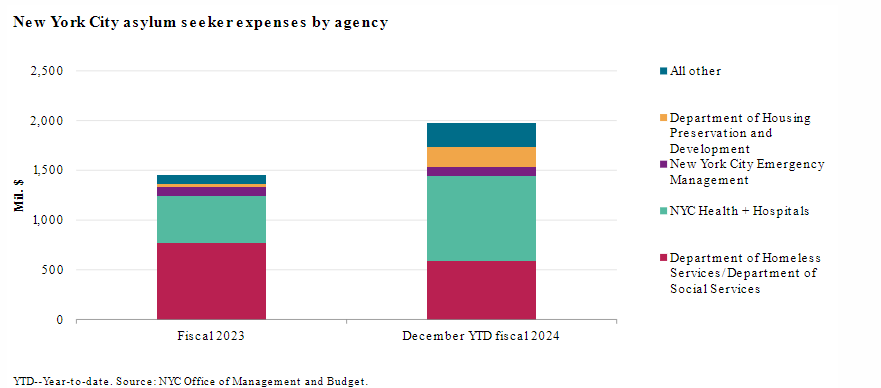In recent years, the United States has experienced a significant increase in the number of migrants and asylum seekers arriving at its borders.
The Department of Homeland Security reports that U.S. customs officers encountered 2.5+ million migrants in 2023 on the southern border. While the humanitarian aspect of this influx is undeniable, it also presents a considerable fiscal challenge for local and state governments across the country. The strain on resources, services and infrastructure is increasing, requiring careful examination and proactive solutions.
In this article, we will take a closer look at how local and state governments share the fiscal strain created by the influx of migrants in the United States.
An Overview of the Migrant Crisis
It’s often covered in the national news that an increasing number of American cities, especially ones near the southern border, like Brownsville, Laredo and El Paso, are declaring a state of emergency due to the large influx of migrants overwhelming the limited resources of the local governments. These limited resources provided by local budgets include everything from healthcare and social services to law enforcement and housing. Another contributing factor to the current crisis is the end of COVID-19 era Title 42, which was invoked to slow the spread of the pandemic across the U.S. borders and give U.S. authorities emergency powers to control the influx of migrants on the southern border. The chart data below, from the U.S. Department of Homeland Security, shows how the response has shifted since the revocation of Title 42:

The constant growth in the number of migrants crossing the southern border has created issues for the fiscal sustainability of cities all across the U.S. As many readers are aware, many migrants, after crossing into the U.S., often end up in larger American cities for better protective policies for migrants and the better prospect of employment.
In the recent report by S&P Global, in addition to U.S. border towns, some of America’s largest cities are feeling the pressure, including New York, Chicago and Denver. The report states, “These cities are adjusting their budgets to accommodate rising expenditures, but without state and federal government support, these costs are significant enough to strain budgets and could pressure credit quality.” Furthermore, the chart below shows the new cases filed by migrants in immigration courts.

Source: S&P Global Ratings
The Impact on Services Provided by Local & State Governments
Healthcare Cost
Migrants and asylum seekers often arrive with various health needs, ranging from basic medical care to chronic conditions. Local health departments and clinics bear the burden of providing healthcare services, regardless of an individual’s ability to pay. The cost of providing healthcare to uninsured migrants and asylum seekers places a significant strain on local healthcare systems. For instance, a study by The Journal of General Internal Medicine found that uncompensated care costs for undocumented immigrants alone amounted to $4.6 billion annually.
Education Expenses
The influx of migrant children places additional demands on local school districts, necessitating additional resources and personnel. Educating children with diverse linguistic and cultural backgrounds requires specialized programs and support services. According to the Federation for American Immigration Reform, the average cost per year to educate a child with limited English proficiency is estimated to be $12,000 to $25,000, depending on the state.
Social Services
Migrants and asylum seekers often require access to social services, such as housing assistance, food aid and employment support. Local social service agencies are tasked with addressing the needs of vulnerable populations, including recent arrivals. The strain on social service programs can lead to longer wait times, reduced benefits and increased administrative costs. A report by the National Conference of State Legislatures highlights the growing pressure on state-funded social programs due to the influx of migrants and asylum seekers.
Law Enforcement and Judicial Costs
Processing and adjudicating asylum claims require significant resources from law enforcement agencies, courts and legal aid organizations. Local law enforcement agencies may face challenges in managing public safety concerns and addressing immigration-related issues. The cost of detaining and processing individuals in immigration facilities adds to the financial burden on state and local governments. The Migration Policy Institute estimates that the average daily cost of detaining an immigrant in a federal facility is $208.
The recent report by S&P Global chronicles the fact that similar to other large cities, New York City has had to revise its budgets due to the surge in migrants during the summer of 2023, as shown in the chart below.

Potential for Positive Economic Impact
While the fiscal strain of accommodating migrants and asylum seekers is evident, there is also potential for economic benefits in the long term. Immigrants contribute to the labor force, consumer spending and entrepreneurship, which can stimulate economic growth.
However, the immediate costs of providing services and support outweigh the long-term economic benefits, creating a fiscal imbalance for local and state governments.
The Bottom Line
The recent uptick in migrants and asylum seekers arriving in the U.S. has placed a significant fiscal strain on local and state governments. The financial burden is widespread and multifaceted, from healthcare and education to social services and law enforcement.
While immigration is a complex issue with no easy solutions, addressing the fiscal challenges requires a collaborative effort involving federal, state and local stakeholders. By investing in comprehensive immigration reform, enhancing coordination between government agencies and exploring innovative funding mechanisms, policymakers can mitigate the fiscal strain and better support immigrant communities and the broader population.





